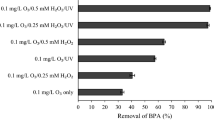Abstract
The ozone oxidation of endocrine disruptor bisphenol A in drinking water was investigated. A stainless completely mixed reactor was employed to carry out the degradation experiments by means of a batch model. With an initial concentration of 11.0 mg/L, the removal efficiencies of BPA (bisphenol A) could be measured up to 70%, 82%, and 90% when the dosages of ozone were 1, 1.5, and 2 mg/L, respectively. The impacts on BPA degradation under the conditions of different ozone dosages, water background values, BPA initial concentrations, and ozone adding time were analyzed. The results showed that ozone dosage plays a dominant role during the process of BPA degradation, while the impact of the contact time could be ignored. UV wavelength scanning was used to confirm that the by-products were produced, which could be absorbed at UV254. The value of UV254 was observed to have changed during the ozonation process. Based on the change of UV254, it could be concluded that BPA is not completely degraded at low ozone dosage, while shorter adding time of total ozone dosage, high ozone dosage, and improvement of dissolved ozone concentration greatly contribute to the extent of BPA degradation. The effects of applied H2O2 dose in ozone oxidation of BPA were also examined in this study. The O3-H2O2 processes proved to have similar effects on the degradation of BPA by ozone oxidation.
Similar content being viewed by others
References
Harries J E, Runnalls T, Hill E, Harris C A, Maddix S, Sumpter J P, Tyler C R. Development of a reproductive performance test for endocrine disrupting chemicals using pair-breeding fathead minnows (pimephales promelas). Environ Sci Technol, 2000, 34: 3003–3011
Maricel V Maffini, Beverly S Rubin, Carlos Sonnenschein, Ana M Soto. Endocrine disruptors and reproductive health: the case of bisphenol-A. Molecular Cellular Endocrinol, 2006, 254–255: 179–186
Alexander H C, Dill D C, Smith L W, Guiney P D, Dorn P B. Bisphenol A: acute aquatic toxicity. Environ Toxicol Chem, 1988, 7: 19–26
Jeong-Hun Kang, Fusao Kondo, Yoshiki Katayama. Human exposure to bisphenol A. Toxicology, 2006, 226(2–3): 79–89
Belfroid A, van Velzen M, van der Horst B, Vethaak D. Occurrence of bisphenol A in surface water and uptake in fish: evaluation of field measurements. Chemosphere, 2002, 49: 97–103
Staples C A, Dom P B, Klecka G M, O’Block S T, Harris L R. A review of the environment fate, effects, and exposures of bisphenol A. Chemosphere, 1998, 36: 2149–2173
Fromme H, Kuchler T, Otto T, Pilz K, Muller J, Wenzel A. Occurrence of phthalates and bisphenol A and F in the environment. Water Res, 2002, 36: 1429–1438
Jin X L, Jiang G B, Huang G L, Liu J F, Zhou Q F. Determination of 4-tert-octylphenol, 4-nonylphenol and bisphenol A in surface waters from the Haihe River in Tianjin by gas chromatography-mass spectrometry with selected ion monitoring. Chemosphere, 2004, 56(11): 1113–1119
Hideyuki Katsumata, Shinsuke Kawabe. Degradation of bisphenol A in water by the photo-Fenton reaction. J Photochem Photobiol A: Chem, 2004, 162: 297–305
Manfred Clara, Birgit Strenn, Ernis Saracevic, Norbert Kreuzinger. Adsorption of bisphenol-A, 17β-estradiole and 17α-ethinylestradiole to sewage sludge. Chemosphere, 2004, 56(9): 843–851
Tsai W T, Lai C W, Su T Y. Adsorption of bisphenol-A from aqueous solution onto minerals and carbon adsorbents. J Hazardous Mater, 2006, 134(1–3): 169–175
Ohko Y, Ando I, Niwa C, Tatsuma T, Yamamure T, Nakashima T, Kubota Y, Fujishima A. Degradation of bisphenol A in water by TiO2 photocatalyst. Environ Sci Technol, 2001, 35: 2365–2368
Boscoletto B A, Gottardi F, Milan L, Pannocchia T, Tartari V, Tavan M. Electrochemical treatment of bisphenol A containing wastewaters. J Appl Electrochem, 1994, 24: 1052–1058
Tanaka S, Nakata Y, Kuramitz H, Kawasaki M. Electrochemical decomposition of bisphenol A and nonylphenol using Pt/Ti electrode. Chem Lett, 1999: 943–944
Tanaka S, Nakata Y, Kimura T, Yustiawati, Kawasaki M, Kuramitz H. Electrochemical decomposition of bisphenol A using Pt/Ti and SnO2/Ti electrode. J Appl Electrochem, 2002, 32: 197–201
Fernando J. Beltrán, Manuel González, Benito Acedo, Francisco J. Rivas. Kinetic modelling of aqueous atrazine ozonation processes in a continuous flow bubble contactor. J Hazardous Mater, 2000, 80(1–3): 189–206
Chu W, Chan K H, Kwan C Y. Modeling the ozonation of herbicide 2,4-D through a kinetic approach. Chemosphere, 2004, 55(5): 647–652
GB/T15437-1995. Ambient Air-Determination of Ozone-Indigo Disulphonate Spectrophotometry. Beijing: State Environmental Protection Administration of China, 1995
Glaze W H, Kang J W. Advance oxidation for treating groundwater contaminated with TCE and PCE. JAWWA, 1990, 5: 57–63
Aieta E M, Reagan K M, Lang J S, Mc Reynolds L, Kang J K, Glaze W H. Advance oxidation process for treatment of groundwater contaminated with TCE and PCE. JAWWA, 1988, 5: 64–72
Duget J P, Bernazeau F, Mallevialle J. Application of combined ozone-hydrogen peroxide for the removal of aromatic compounds from a groundwater. Ozone: Sci Eng, 1990, 12: 281–294
Glaze W H, Kang J W. Advanced oxidation process: description of a kinetic model for the oxidation of hazardous material in aqueous media with ozone and hydrogen peroxide in a semibatch reactor. Ind Eng Chem Res, 1989, 28: 1573–1580
Author information
Authors and Affiliations
Corresponding author
Additional information
Translated from Environmental Science, 2006, 27(2): 294–299 [译自: 环境科学]
Rights and permissions
About this article
Cite this article
Xu, B., Gao, N., Rui, M. et al. Degradation of endocrine disruptor bisphenol A in drinking water by ozone oxidation. Front.Environ.Sci.Eng.China 1, 350–356 (2007). https://doi.org/10.1007/s11783-007-0060-y
Issue Date:
DOI: https://doi.org/10.1007/s11783-007-0060-y




